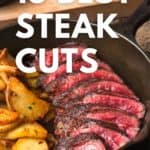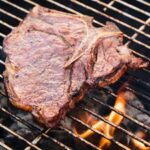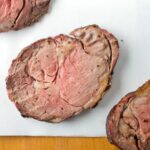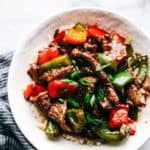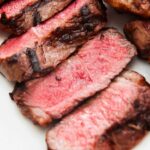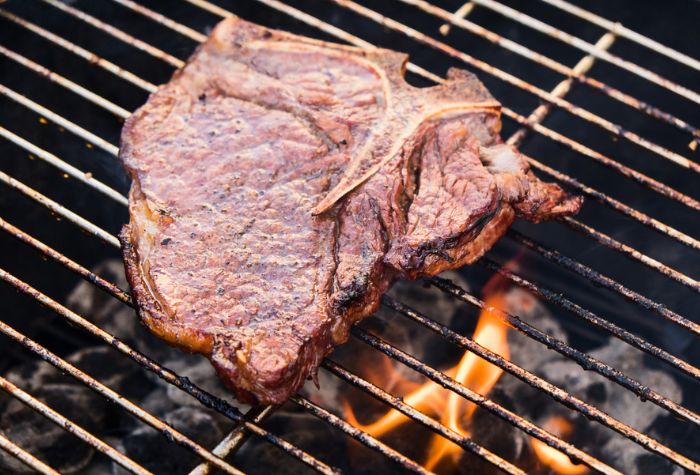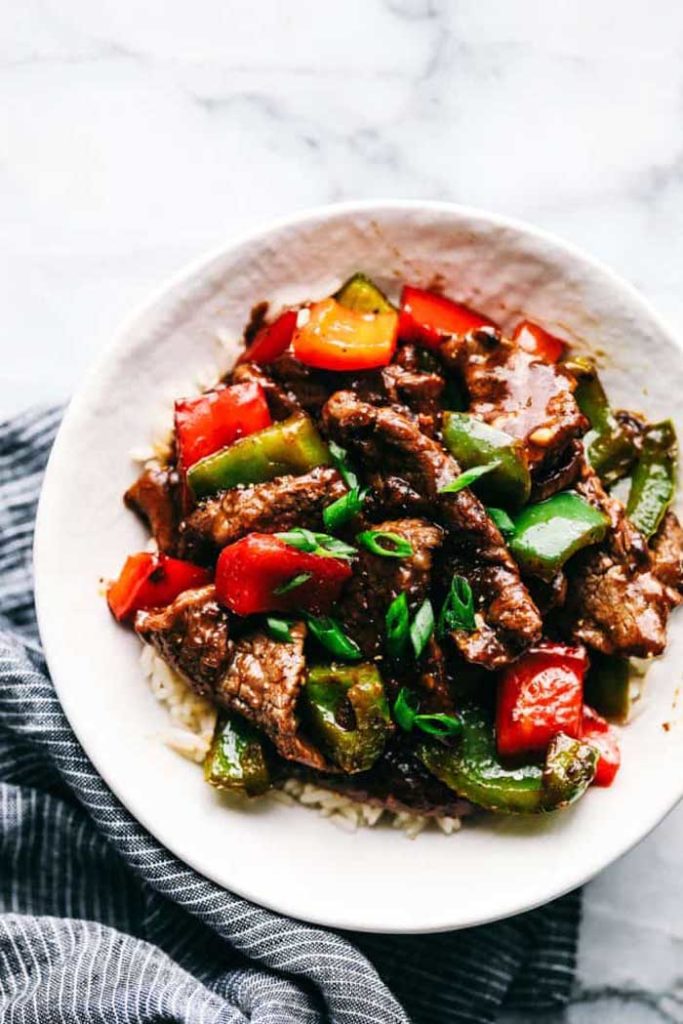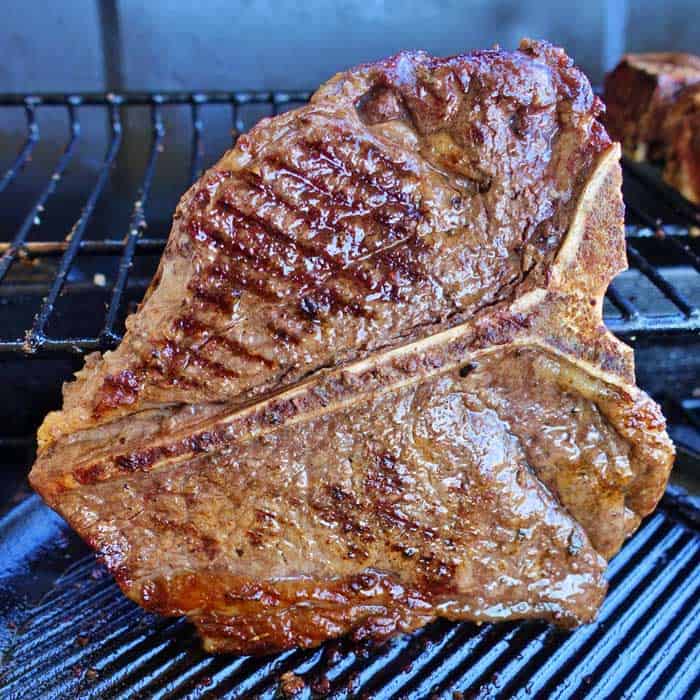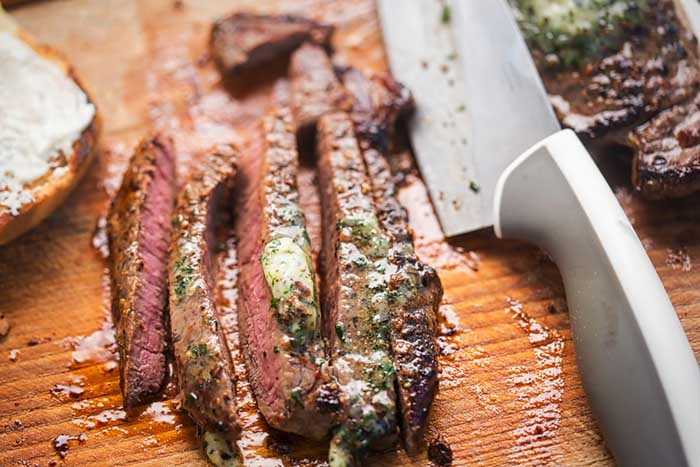Is there any meat better than barbecue beef steak? From ribeye to New York strip, the variety of steak cuts gives you endless options when grilling. Find out everything you need to know about the different cuts of steak and how to cook them.
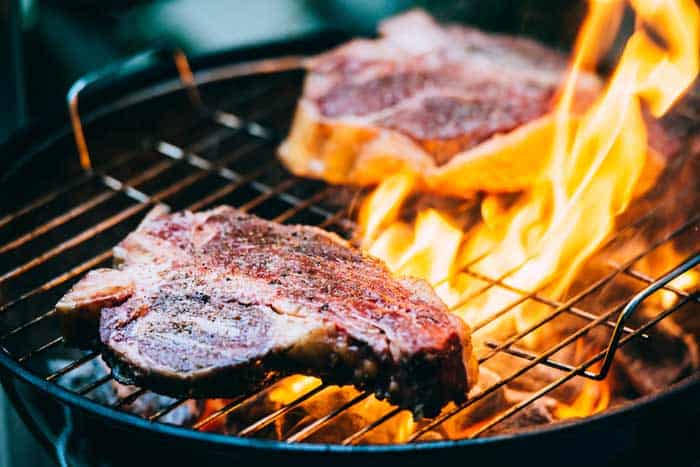
Steak is king when it comes to grilling, and it’s not difficult to see why. Whether it’s medium-rare sirloin or a tomahawk centerpiece, a high-quality steak will always steal the show.
So where do you start choosing your next cut of beef? In this meat guide, we’ll show you the best steak types for you to throw on the grill this year. Let’s get into it.
Tomahawk
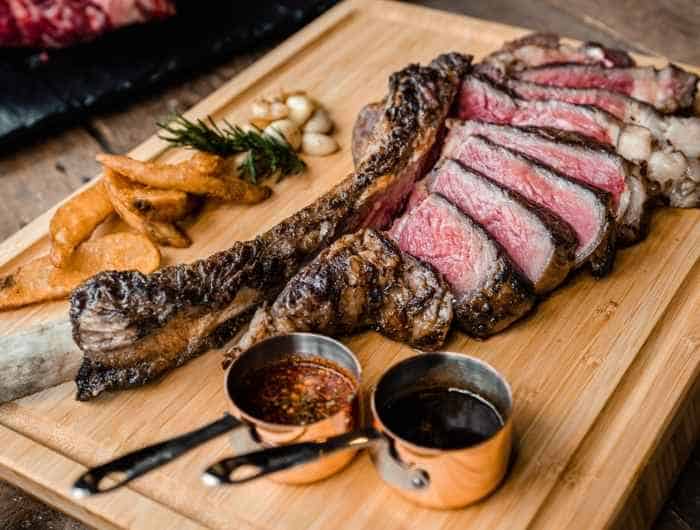
Is there any meat more iconic than Tomahawk steak? This centerpiece meat is a beauty and offers far more than just a big piece of bone and presents an excellent challenge to anyone wanting to hone their grilling skills.
The tomahawk steak is a beautiful cut of bone-in ribeye that gets its name from the large bone that protrudes from the large part of meat taken from the cow’s ribs.
Most tomahawk steak cuts are at least two-inches thick, and the bone is about seven inches long. It looks incredible, especially when cooked to perfection on the inside with a charred crust outside.
Tomahawk steaks are frenched – a stage of meat prep used for lamb, pork, and beef ribs, whereby the meat and fat are separated from the end of each bone. It’s a time-consuming process, but one that yields an elegant presentation.
How to Cook It
One of the best ways to cook tomahawk steaks is to employ hybrid grilling. This involves slowly smoking the beef to just below your desired doneness before searing it over high heat to finish it off. This is best done using a charcoal or pellet smoker before transferring it to a grill for searing. However, you can also do it by roasting it in the oven before grilling or pan-searing it.
Prepare the tomahawk with a simple herb and spice rub and a touch of butter. Smoke at 225°F (107°C) until the internal temperature reaches 125°F (50°C) for medium-rare. This usually takes 45-60 minutes but may take longer.
Transfer the steak to a preheated grill at high heat, flipping every 2-3 minutes until the outside has developed your preferred amount of crust. Remove from heat and allow to rest. See our full reverse-seared tomahawk steak recipe for more details.
Flank
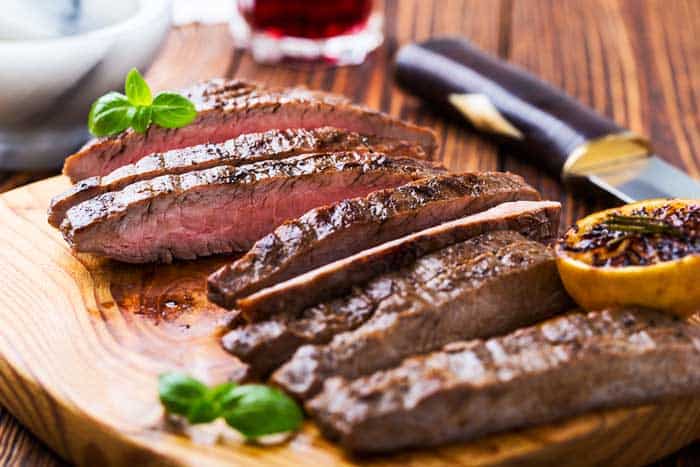
Flank steak is a beautiful lean and tough steak cut that boasts a rich beefy flavor. Many people might go for sirloin or strip as their go-to grilled steak choice, but flank steak is much more versatile and flavorful.
Flank comes from the cow’s bottom abdominal area, making it lean and rich in tough muscle fibers. This composition is what loads it with a uniquely intense flavor.
Flank is one of the most trusted cuts of beef for making jerky. However, just like sirloin, it’s also a little dearer than round or shank, so the price can be a little eye-watering to newcomers.
How to Cook It
Cooking hot and quick is the best way to get the most out of flank. It goes well grilled or seared and even prepared as reverse-seared flank steak.
For simple grilling, it only needs to be grilled at high heat for 5 minutes per side until you have reached desired doneness.
For reverse searing, smoke it at 225°F (107°C) until the internal temperature is 120°F (50°C) for medium-rare. This should only take about 40 minutes but may take a little longer. Transfer to a preheated grill at high heat, turning every 2-3 minutes until it has developed a nice crisp on the outside.
Skirt
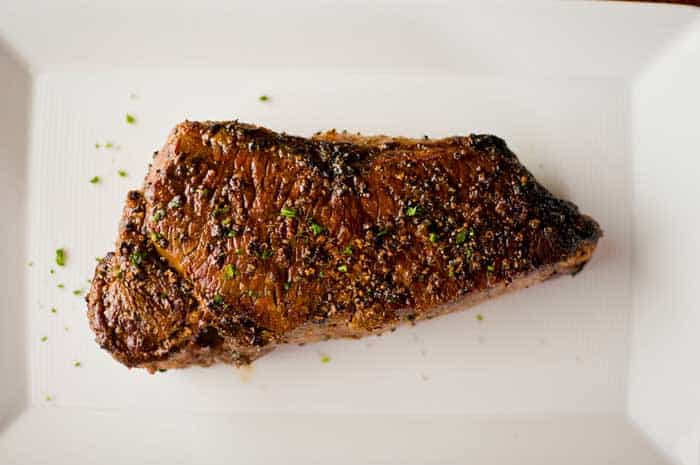
Skirt steak is a notoriously tough cut of meat that carries tough muscle fibers, making it difficult to cut and often tough to chew.
While some other steak cuts can be smoked or reverse seared, the skirt is so tough that it can only be enjoyed rare or medium-rare. Because of this, it needs to be pan-seared or grilled at high heat.
It may be less tender than other steak cuts, but this robust and tough construction is what makes skirt so unique. It is bursting with flavor and, while it can be served alone, it is an ideal filling for BBQ sandwiches, fajitas, and tacos.
Skirt steak comes from the beef plate primal and has two forms: ‘Inside’ skirt and ‘outside’ skirt. ‘Inside’ skirt comes from the lower end of the ribs and is cut from inside the beef. It has a more consistent shape and texture but can start to shrink as you cook it.
‘Outside’ skirt runs across the beef’s diaphragm muscle and chest wall, from the 6th to 12th ribs. It tends to carry better flavor, thickness, and consistency than inside skirt.
Whichever you choose, skirt steak tends to be thinner than most other steaks, so it will cook a lot quicker. It only needs to be grilled for two to three minutes on each side.
How to Cook It
Marinate the steak for at least an hour to help tenderize it and break down its tough muscle fibers. Fire up your grill to high and with the racks placed directly over the heat. While it preheats, pat the steak dry (this will help with the Maillard Reaction, giving us great flavor).
Grill for two to three minutes per side, until char lines develop and you have reached medium-rare doneness. Remove from heat and leave to rest for five minutes before serving.
T-Bone
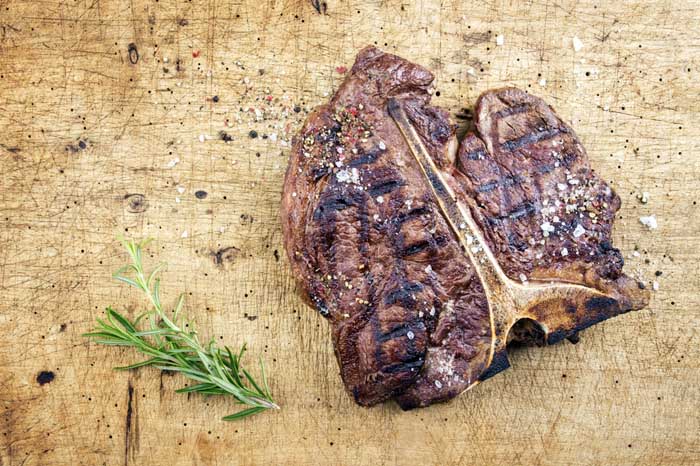
The T-Bone steak is another cut where the name gives you a good indication of the shape. T-bone steak is cut from the short loin of the cow but still contains a strip of both top loin and a section of tenderloin.
Both those cuts are tasty and sought after on their own but put them together with a little t-shaped piece of bone at the top, and you have one of the most popular (and pricey) restaurant-served steaks.
Like the Tomahawk, the t-bone is another bone-in cut of steak – not only does the bone help to keep both sides of the cut together, but it can also help when cooking the meat as it slows down the heat distribution, so you’re less likely to get an overcooked steak.
Flavor-wise, you’re getting the best of both worlds with a t-bone steak – you’ve got the beefy taste of strip loin on one side and the tender fillet on the other.
How to Cook It
Cooking a T-bone steak to perfection can seem tricky, but it’s just a case of knowing how the steak is made up and where to position it over your heat.
Slowly smoked over low heat before seared over high temperatures, this reverse-seared T-bone recipe is the perfect way to enjoy this premium beef cut.
The slowest cooking part of the steak is the strip side, particularly the part that sits in the bend of the bone at the base of the cut. This side should be placed over direct heat to sear and cook, while the filet side should sit further away from the direct heat.
Porterhouse Steak
The Porterhouse steak is cut from the short loin of the cow but in a way so that it contains a strip of both top loin and a section of tenderloin…have you got deja vu? That sounds exactly like a T-bone steak, right?
Steak Size Matters
If we’re talking about things from a meat cut point of view, a Porterhouse steak is exactly the same cut as a T-bone steak. It’s a bone-in cut made up of a tenderloin steak on one side and a strip steak on the other. The difference is that T-bones are cut from the front of the short loin, whereas porterhouse comes from the back. This makes the Porterhouse at least 1.25 inches wide, whereas T-bones are slimmer.
To make a Porterhouse steak, the tenderloin portion needs to be at least 1.25” wide at its thickest part. Any smaller than that, and it’s relegated to the equally tasty but slightly smaller T-bone status.
Strip
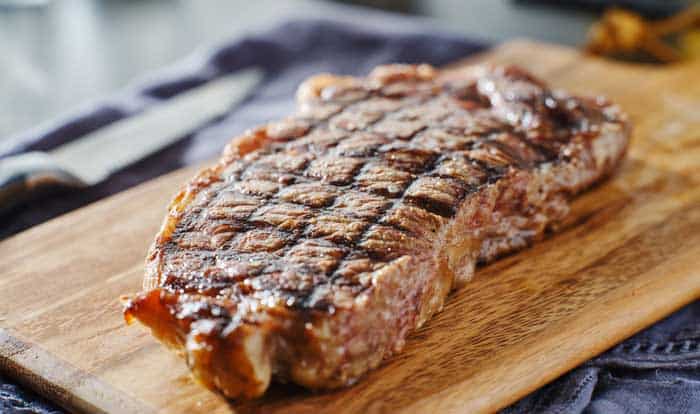
Strip steaks are a rich, flavourful, and tender cut thanks to a good amount of marbling and a fat cap along one edge. Often referred to as the New York Strip Steak, this cut comes from the loin sub-primal and may look familiar if you’re a fan of T-Bone steak. Strip steak is the cut that makes up one-half of a T-Bone steak along with the tenderloin; the cut can sometimes be left as a ‘bone-in’ steak and renamed as a Club or Shell Steak.
Strip steak is a good middle ground for both flavor and texture between the beefy Ribeye and buttery Filet Mignon. The degree of intramuscular marbling that a Strip steak has, helps keep it juicy when cooked and contributes to why it’s one of the higher price cuts of steak.
How to Cook It
Strip steaks should come well trimmed so there likely won’t be much preparation needed before cooking other than a pat down with a paper towel and seasoning with salt.
Strip steak is ideally served medium-rare, so you’ll want a fast cook on high heat. Sear and cook the strip steak for a few minutes on each side and leave to rest before cutting or serving.
See our grilled New York strip steak to see how it’s best enjoyed. With just a little bit of seasoning and butter, this recipe lets this beautiful cut of beef do all the talking.
Ribeye
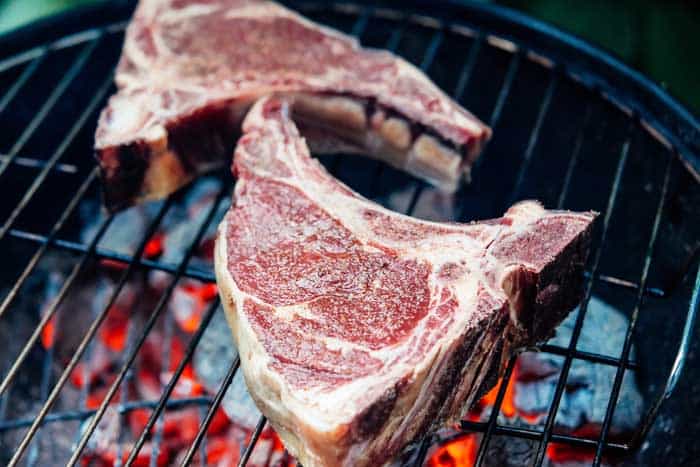
Ribeye steak is a primal cut of beef from the upper rib section of the cow. It has a heavy amount of fat marbling which gives it its flavor and juiciness, and a layer of fat surrounding the ‘eye’, which separates the two muscles that make this cut of beef.
Ribeye is a boneless steak as a general rule, but you can have it as a bone-in cut. When the bone is left intact, it’s called a ‘rib steak’.
Two common forms of rib steak are the cowboy steak, a large ribeye with a french trimmed bone left in, and a tomahawk steak, a large ribeye steak with the bone left in and protruding to resemble an axe handle.
The main things you are looking for when picking a ribeye steak are a good distribution of marbling and a nice ‘eye’ of fat separating the two muscles. This ‘eye’ is what helps to give the ribeye its characteristic beef flavor.
How to Cook It
Ribeye steak will taste great if cooked on the grill, but due to the high-fat content, you need to take care to avoid flare-ups from fat dripping onto open flames. A better way to cook a ribeye steak is by using a skillet:
- Place your skillet on high heat and let it get sizzling hot.
- Season your steak with a sprinkle of salt and place in the skillet allowing it to cook for at least 5 minutes on each side (or until it is close to medium doneness)
- Remove from the heat and leave it to rest tented in foil with a knob of butter.
- Once it has rested for a minimum of 10 minutes, it’s ready to slice against the grain and serve.
Sirloin
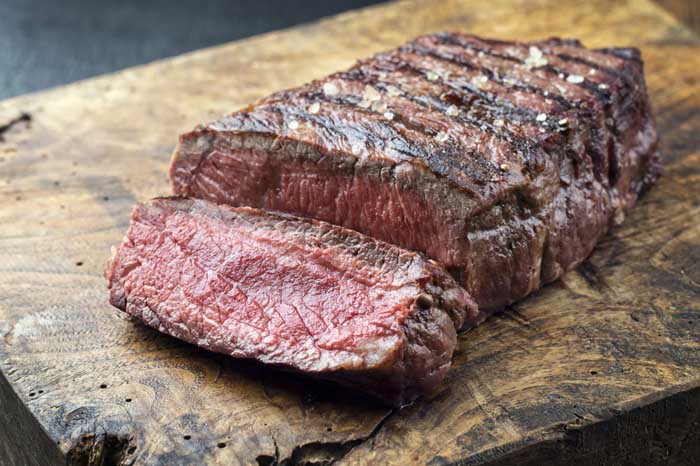
We all know and love the sirloin steak – it’s juicy, delicious, and great for grilling. From the sirloin primal, the actual part we use for sirloin steaks is known as the top sirloin butt, whereas the bottom sirloin butt is used to create cuts for ground beef, stews, or roasting.
Sirloin steak is a lean and juicy cut with a moderately beefy flavor. It doesn’t have much fat marbling running through it. So to get its optimum level of tenderness, it should be cooked to medium-rare doneness.
Sirloin steak is a great ‘steak dinner’ cut of beef – it goes well with a side of chips or vegetables and is often served as such in restaurants. Since it is a lean and relatively affordable cut of meat, it is also often used in stir fry dishes or as an addition to pasta dishes.
How to Cook It
Sirloin steak is an ideal cut to cook on the grill with a two-zone setup. First, you want to sear your steaks on the hottest side of the grill for 1-2 minutes on each side. Then they can be moved over to the indirect heat side of the grill to finish cooking through. For a 1-inch thick sirloin steak, it’ll need around 10 minutes cooking on the grill to reach medium-rare but, as always, the best way to measure doneness is by using a meat thermometer.
Round Steak
Round steak, also known as Rump steak for our British and Australian readers, is a lean but tasty cut that comes from the round primal at the back end of the cow. Since it is considered a tough meat, beef round is often used for ‘low and slow’ cooking like roasts and stews. It can be used for steaks, but they benefit from being tenderized or marinated before cooking.
Since the round steak comes from the hip and leg area of the cow (the muscle group surrounds the femur bone), it’s a well-worked area, making the cut leaner and less tender than some others, but it still has a good beefy flavor. It’s one of the more affordable cuts of meat and is very versatile once you learn how to prepare and cook it.
How to Cook It
Round steak can be eaten in a number of ways and is a very versatile cut of beef. As it is a lean cut, if you want to use round for grilling steaks, it is best to marinate them before cooking to help tenderize the meat.
Care should also be taken not to overcook round steak on the grill – the grain on round steak is very tight and firm, so if it is cooked for too long, that grain shrinks up with the loss of moisture and can become chewy.
To grill beef round steak, place it on a medium to high heat grill for around 6 minutes per side. It should only need flipping once and will be ready to eat when it reaches an internal temp of 145℉. Once removed from the grill, it can be cut against the grain to produce tasty round steak strips.
Round steak is an excellent cut for some delicious low and slow cooking, such as roasts or stews. Roasted beef round can be sliced thinly to make roast beef slices perfect for sandwiches or served as a cold cut. Cubed round beef works great in stews or liquid-based dishes as they help keep the meat moist.
Denver Steak
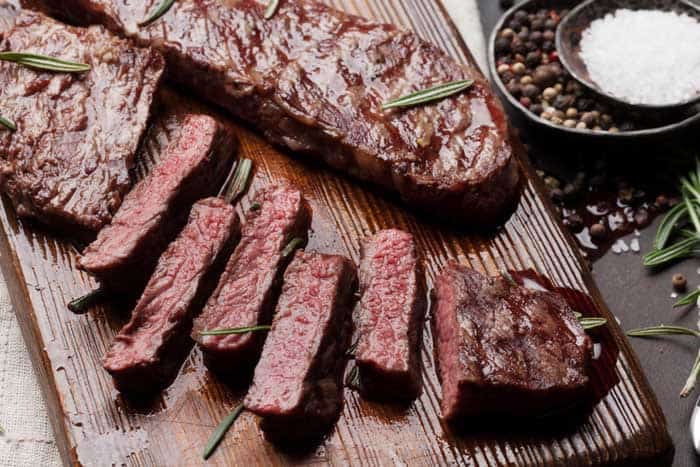
Denver steak might not be a cut of beef that you’re overly familiar with because it was only discovered and popularised in recent years.
It’s a tasty and budget-friendly cut that comes from the chuck primal area of the cow in an area that would be best described as the top of the shoulder.
Now, I know what you’re thinking, top of the shoulder? That’s an area of the cow that’s pretty well used for walking and grazing; surely it’s going to be a tough and sinewy cut full of connective tissue?
Well, you wouldn’t be wrong! The chuck primal is known to be a tough area and is one of the lower value primal cuts on a cow, BUT the Denver steak cut has actually been hiding in plain sight from us all this time.
The Denver Steak was discovered by Dale Woerner in the early 2000s. Dale was a meat scientist and professor at Colorado state university tasked with finding ways to make lower-value cuts of meat more appealing and valuable. While exploring the tough chuck, he came across the Serratus Ventralis muscle, which sits inside the chuck primal, under the shoulder blade. As this muscle sits behind the shoulder blade, it isn’t used much at all, making it one of the most tender cuts of meat from that primal!
The Denver steak is cut from one of the most heavily marbled muscles in the cow, giving it a rich beefy flavor. That marbling also gives it a deliciously tender texture (it’s actually been ranked as the 4th most tender cut of beef!) and stays juicy as long as it’s cooked properly.
As it’s a relatively new cut of beef, you’re not likely to find it in supermarkets and may need to find a specialist butcher to be able to purchase it.
How to Cook It
Since the Denver steak is such a new cut, there isn’t a ton of info out there on different ways to cook it. As it’s associated with the tough primal chuck that it’s cut from, people often assume it has to be cooked low and slow, but that’s not the case!
Following advice from the man who discovered it, the amazing flavor from the Denver should be allowed to shine through and not over prepared.
- Pat your Denver steak dry and lightly season with salt before adding it to a sizzling hot griddle.
- Cook over high heat until it has started to crust, then turn the steak. Once the other side has also developed a crusted edge, reduce to medium heat and add a large knob of butter.
- Leave the steak in the butter for a few moments before removing it from the heat and allowing it to rest for 3-4 minutes.
Denver steak is best served as rare to medium-rare and cut across the grain.
Flap Steak
Beef flap steak is a type of steak that is usually tougher than others. It is cut from underneath the cow’s belly and is best cooked in a slow cooker or on low heat in a skillet. Beef sirloin tip is a small, triangular-shaped cut of beef with long grain and an immense, intense flavor. It’s an excellent cut for stir-frying and a great steak to pan-sear or grill.
Rump Steak
Beef rump steak is a cut of beef from the highest part of the animal’s rump. It is often overlooked because it is leaner than other beef cuts, but it is quite tender and flavorful. It’s a hardy cut of meat that stands up well to being served in various dishes. If you’re a fan of beef but are looking for a more affordable cut, you should consider beef rump beef. The cut is tender and juicy and makes for a delicious dish.
Hanger Steak
Hanger steak is not a cut that most are familiar with in North America. While it’s been a longtime favorite in Europe, it’s only recently started appearing in steak restaurants in the US and Canada.
It’s a versatile cut with an intense flavor thanks to its considerable marbling and the fact that it doesn’t do too much work as a muscle. It’s the plate primal area under the cow that runs from the diaphragm to the belly, and literally ‘hangs’ under the cow (hence the name!).
Hanger steak is often considered the second most tender cut on the cow (the first being the tenderloin). Its rich grain is similar to skirt, but hanger’s intense beefy flavor is closer to that of ribeye.
Steakhouses usually serve hanger steak as a dish with fries or vegetables, but in South America and Mexico, you can often find it used as beef strips for tacos or fajitas.
How to Cook It
Hanger steaks can get tough if cooked incorrectly. While it has a lot of fat marbling, it still benefits from being marinated in something with an acid component (a marinade with vinegar or citrus juice, for example) to help tenderize and add moisture to the meat before cooking. Hanger steak tastes best-served medium-rare and cut across the grain.
It’s a ‘high and dry’ kind of steak, so you want to cook it on a searing hot grill, and it should only need 3-4 minutes on each side.
Flat Iron
Beef flat iron steak is cut from the shoulder blade primal cut. It is a cut that is often used to make cube steak or thinly sliced fried steak. These meat cuts are known for their tenderness and are a popular choice for cooking for a large number of people. Beef chuck steak is best known for being relatively affordable and tender, and it’s common in dishes like beef Stroganoff. The chuck primal cut is also known as the shoulder.
Cube Steak
Beef cube steak is a cut of beef that is typically cube-shaped to make it easy to cook. It has a smaller surface area than a steak cut from the same meat piece, making it easier to sear and cook. Beef cube steaks are usually graded as Select, Choice, or Prime, with Prime being the most expensive. Cube steak is often seasoned with salt, pepper, and garlic and then fried with butter in a pan. The beef is usually tender and juicy and has a nice beefy flavor. The steak is one of the most popular types of steak on the market today and is often served at steakhouses and restaurants.
Filet Mignon
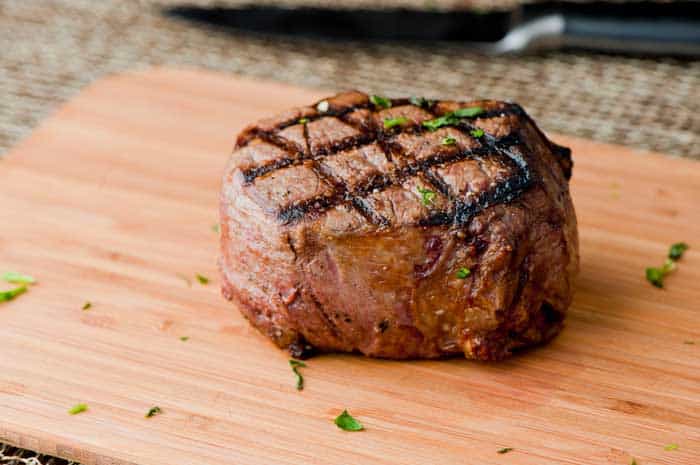
You know you’ve got an expensive cut of meat when it’s got a fancy French name, but believe it or not, ‘mignon’ literally translates to cute or small.
The filet mignon is a cut from the tenderloin muscle (a name that is interchangeably used for this cut). The tenderloin is a muscle that isn’t used by the cow for grazing or walking, so it remains nice and tender, making this cut one of the tastiest and priciest steaks.
Filet mignon is a fine-grained steak with no connective tissue and very little fat marbling. Due to this, it has a delicate, buttery texture instead of a beefy flavor. The lack of fat marbling means it can dry out if overcooked. Pair that with its milder flavor, and you’ll often see filet mignon cooked with a strip of bacon wrapped around it – this is to add some extra oomph and help retain moisture.
A well-cooked filet mignon is a showstopper piece, so it isn’t often used as part of a dish – it is the dish.
The only real exception to this is when it is used in Beef Wellington.
How to Cook It
There is very little prep needed for a filet mignon steak as the cut is trimmed of all surrounding fat. All that’s needed is a little sprinkle of salt and pepper and wrapping in bacon if that is your preference.
The key thing to get right when cooking tenderloin steak is the temperature. They are best served medium to medium-rare (any more than that and you can lose the tenderness).
To cook a filet mignon steak on the grill:
- Place it over medium-to-high direct heat, close the lid and allow to cook for 3 minutes
- Open the girl, turn the steak 90 degrees (to get the characteristic diamond grill marks), and cook for a further 2-3 minutes
- Flip the steaks and do the same on the other side
- Once the internal temperature reaches 125-130°F, the steak can be taken off and left to rest for 5 minutes. This should result in a medium to medium-rare doneness
London Broil
London Broil is a catch-all term for various beef cuts based on the rump, which is tougher and has more connective tissue. A London broil is traditionally made with beef cut from the chuck, a cut of meat from the shoulder. It is usually served sliced and unseasoned and served in a bowl. This dish is most popular in the United States but can be found in many other countries.
